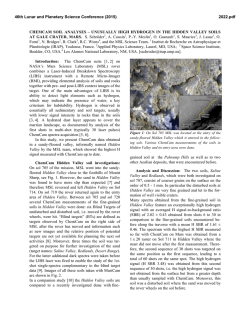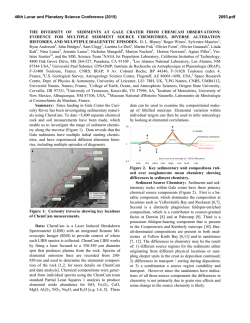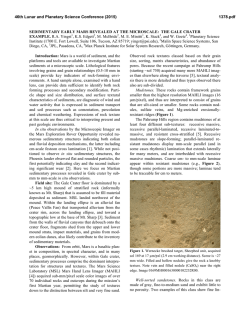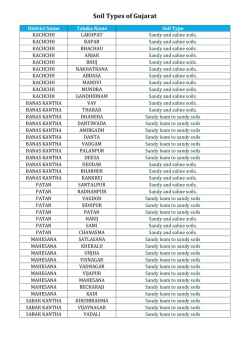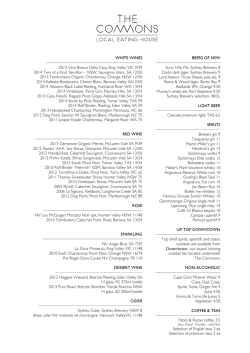
Pahrump Soils and Comparisons with Previous Aeolian Deposits
46th Lunar and Planetary Science Conference (2015) 2767.pdf Pahrump Soils and Comparison with Previous Aeolian Deposits A. Cousin1, S. Schröder2, P.Y. Meslin2, O. Gasnault2, O. Forni2, B. Clark3, W. Rapin2, J. Lasue2, C. Fressinet4, N. Bridges5, S. Clegg1, A. Fraeman6, J. Blank7, S. Maurice2, R.C. Wiens1.1LANL, Los Alamos, NM, USA; 2IRAP, Toulouse, France; 3Space Science Institute, Boulder, CO, USA ; 4NASA Goddard Space Flight Center, Greenbelt, MD, USA; 5Applied Physics Laboratory, Laurel, MD, USA; 6Caltech, Pasadena, CA, USA ; 7NASA Ames Research Center, CA, USA. [[email protected]] Introduction: The ChemCam instrument [1,2] onboard the Curiosity rover provides for the first time an opportunity to study martian soils at a submillimeter resolution. In this work, we focus on soil targets at the Pahrump Hills location (Fig. 1) on sol 801. This location consists of an aeolian deposit, where fine-grained soils (i.e. with no coarse-grains > 150 microns) have been analyzed. The previous soils targeted by ChemCam from an aeolian deposit before Pahrump was within Hidden Valley (a partially enclosed topographic basin) that was reached around sol 710. Soils analyzed in this area have shown interesting results and are discussed in a companion study [3]. The objective of this study is to compare the Pahrump soils to previous aeolian deposits, as well as to all the previous fine-grained soils analyzed using the blind sampling mode. Data: This study focuses on fine-grained soils targeted in the Pahrump area, on the trench made by the rover on sol 801. Five soils have been sampled: two 1x5 rasters, one 1x10 raster and two depth profiles with 50 shots each (instead of the 30 shots performed for typical rasters). Therefore a total of 22 points (700 shots) were used to sample soils in this region. These are compared to Hidden Valley where 7 soils were analyzed, with a total of 1650 shots (see [3]). Two other aeolian deposits were previously sampled by ChemCam: Rocknest and Dingo Gap. Six soils have been sampled at Rocknest, with a total of 40 points sampling fine-grained soils only. Fewer soil samples have been analyzed at Dingo Gap, with only 10 points in fine-grained soils. These data obtained in fine soils are compared to each other but also to the average of fine-grained soils, obtained using all the data acquired in fine soils from the blind targets. The blind targeting mode [4] allows the analysis of after drives without specifically selecting targets from survey images. This is very useful on long drives, where the rover moves every sol, and images of the after-drive location, normally used for ChemCam targeting, are frequently not received on the ground before the next uplink sol. The mast is pointed to -42° and the observation is taken at the right-side of the rover. This ensures a good LIBS performance with a target at a distance of ∼3 m. An RMI image is taken before and after LIBS for geological context; dark spectra are also taken before and after LIBS [5]. A MastCam image is usually also taken for context. Figure 1: A. Localization map of Pahrump, and other aeolian deposits visited by Curiosity along the traverse. B. MCAM mosaic of Pahrump’s trench. Grain size: At the surface, these four locations show different grain sizes. The coarsest grains are observed at Dingo Gap and can be up to gravel in size (up to 3 mm [6]). Soils encountered in surface at Rocknest correspond up to very coarse grains (1.5 mm), whereas then at Hidden Valley and Pahrump soils, grains are at maximum coarse grained (1 mm). At least one trench was made at each of these aeolian deposits except Hidden Valley. From the images, we can observe that with depth the grain size seems to be similar at each location. Soils at depth have finer grain size than the LIBS diameter (< 500 microns) and correspond to medium sand and finer particles [6] (Fig. 2). Chemical analysis Studies have shown that some coarser grains are from local inputs whereas others are from a more global source [7, 8]. Therefore only fine-grained soils (size < 0.5 mm and thefore smaller than coarse sand) are taken into account for the chemical analysis in this study, in order to limit local inputs. Table 1 shows the average composition of each fine-grained aeolian deposit. They all have a composition typical of soils, with very low SiO2 content and low total of major-element oxides. Nevertheless one difference is noticeable: the CaO content doubles from 46th Lunar and Planetary Science Conference (2015) Rocknest up to Pahrump (Fig. 3). Dingo Gap and Rocknest are depleted in CaO compared to all the finegrained soils observed in Blind Targets, whereas Hidden Valley and Pahrump are enriched. Figure 2 : RMI and MCAM images for some targets acquired at each aeolian deposit visited by Curiosity and analyzed by ChemCam. Table 1: Average composition of each aeolian deposit, taking into account only fine-grained soils. Composition is estimated using the PLS technique [9, 10]. Figure 3: Variation of ratio CaO to SiO2 for each aeolian deposit. The red dashed line corresponds to the average of all fine-grained soils from the blind targets. Concerning the minor and trace elements (Fig. 4), Dingo Gap soils seem to be depleted in these compared to other soils. Nevertheless this seems consistent, as this aeolian deposit shows the highest major-element total. Rocknest soils are the richest in Li and Mn. This could be explained by local inputs, Rocknest rocks being enriched in Fe. Hidden Valley and Pahrump soils are the most enriched in Cl, Sr and Cr, Hidden Valley showing more Cl and Sr compared to Pahrump. The H signal is the highest in Hidden Valley soils, and the next highest in Pahrump soils. A detailed study about 2767.pdf H in Hidden Valley soils is presented in a companion study [3]. Pahrump soils are thus distinctive for their high Ca content (highest in soils so far) and higher Cl and H signals compared to all the soils (but overall lower than Hidden Valley). Figure 4: Cl peak area variations for each aeolian deposit. Discussion: The sampled aeolian deposit in the Pahrump area consists of fine-grained (<500 microns) soils relatively enriched in Cl and H, and the most enriched in Ca compared to other deposits visited by the rover. But no obvious correlation has been observed between Ca and Cl, or between Ca and H. Nevertheless a clear one is present between Cl and H. These observations could lead to several hypothesis; these soils could be enriched in a) perchlorates, which could explain the enrichment in Ca, Cl and H, b) in CaCl2 – this being hygroscopic, the presence of water is well explained, c) airfall deposits, which would explain enrichment in Cl and H but maybe not the higher content of calcium. Nevertheless, SAM revealed that the drilled rock at Confidence Hills (closed to Pahrump soils) is the poorest in perchlorates compared to Rocknest aeolian deposit [11]. Moreover, it seems that the aeolian deposits that are the less active (Rocknest, Dingo Gap) because of their coarser grains in surface are less enriched in H and therefore in water, contrary to the finer-grained dunes, more active, that are richer in water. Acknowledgement: This work was supported by NASA’s Mars Exploration Program, the Centre National d’Etudes Spatiales (CNES) in France and by Mars operations were provided by JPL-Caltech. References:[1] Wiens et al. 2012, Space Science Reviews 170; [2] Maurice et al. 2012, Space Science Reviews 170, [3] Schröder et al., 2015, this meeting ; [4] Cousin et al., 2014, LPSC 45th #1278; [5] Schröder et al., 2014, Icarus, in press; [6] Wentworth 1922, J. Geol. 30, 377–392; [7]Meslin et al., 2013, Science 341; [8] Cousin et al., 2014, Icarus in press; [9] Wiens et al., 2013. Spec. Chem. Acta B. 82, 1; [10] Clegg et al., 2009. Spectrochim. Acta, B, 64, 79. [11] Archer et al, this meeting.
© Copyright 2025
